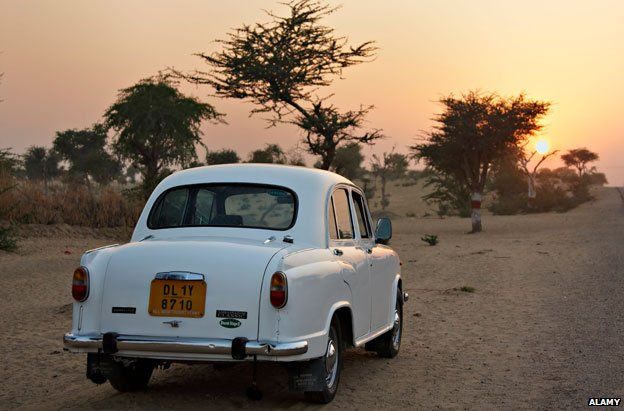An epitaph for India's 'appalling' national car
- Published

Production of the Ambassador, the first car to be made in India, has been halted because of falling demand. Modelled on the Morris Oxford, the car's design has changed little since it first went into production in 1957. But motoring journalist Hormazd Sorabjee is not too upset to see it go.
Generations grew up with this car. It was a taxi for many and a family car for the rich. It transported prime ministers, MPs and bureaucrats. It was truly India's national car, dominating the roads for decades.
When India's economy was liberalised in the early 1990s, global carmakers and their latest models were allowed into the country for the first time. But the Ambassador continued to have a loyal, although fast-shrinking, fan following.
It was an all-purpose car with a large boot and room for six passengers - but it was the back seat that was its trump card.
Modern cars in their quest for sleeker styling and better dynamics come with lower rooflines. They can never match the Ambassador's high seating position and generous headroom. This made getting in and out easy, while the car's low front bench gave rear passengers a fabulous, uninterrupted view of the road ahead.
Today's cars with their big bucket seats, thick pillars (structural uprights that support a car's roof) and high window lines just don't have the same sense of airiness.
There can be no doubt, the Ambassador's demise marks the end of an era. However, for me, it's an era best forgotten.
The Ambassador was a symbol of all that was wrong with India's controlled economy and its stifling regulations. Carmakers could not increase prices or make more cars without the government's approval. They couldn't import technology or components and had to make do with locally developed bits and pieces that were shoddily produced.
Buyers were saddled with cars of appalling quality, which constantly broke down and yet the waiting list to buy one could stretch up to eight years!
Along with every motorist of my generation, I was at the receiving end.
You needed really strong triceps to work the ridiculously heavy steering, the deftness of a surgeon to slot home the spindly column shifter into each gear (shifting from second to third gear was an art form) and immense strength to make the car stop - you had to nearly stand on the brakes.
And the handbrake? It rarely worked but instead spawned a generation of drivers that could easily do hill starts deftly balancing the accelerator and brake.
The Ambassador had other idiosyncrasies. The indicator controls were mounted on the top of the steering hub and a button on the floor operated the headlight dipper.
And there were Ambassador jokes aplenty, my favourite one being: "The only thing that doesn't make a sound in an Ambassador is the horn!"
Though it was sturdy, tough and could withstand terrible roads thanks to its beefy leaf-spring suspension and large 15-inch wheels, the car's habit of breaking down was no laughing matter. The good thing was that you could get spares and a mechanic just about everywhere to fix it too.
There was a troublesome design flaw in the ageing Austin-derived 1.5-litre petrol engine.
The mechanical fuel pump was positioned just under the hot exhaust manifold - a collection of tubes that channel the gases from the cylinders of an engine to the rest of the exhaust system.
This may not have been a problem in cold and rainy England but during the scorching Indian summers, the fuel in the pump would evaporate causing a "vapour lock". This left you hopelessly cranking an engine that would refuse to start.
Indian ingenuity came to the rescue in the form of a wet rag which, when placed on the hot fuel pump, would cool the line down and resume the fuel supply to the engine.
For the best part of 30 years, the Ambassador got only minimal cosmetic upgrades. The first big change, possibly prompted by emission regulations, was an all-new engine. The old 1.5-litre BMC engine from Britain's Austin Motor Company was replaced with a more modern 1.8-litre Japanese Isuzu motor - bringing a 50% increase in power.
When I tested the Ambassador for an automobile magazine in the mid-1990s, it was the fastest-accelerating car in India, outpacing the more modern Fiats and Maruti-Suzukis of that age. That it needed the length of an airport runway to stop it was another matter. The maker had barely upgraded the brakes.
The last time I sat in an Ambassador was a couple of years ago in the eastern city of Calcutta.
It was a fairly new taxi with a nice springy seat. I was looking forward to the ride but I must admit I came away disappointed.
The ride on those cart-like rear leaf springs felt rudimentary, the differential whined like a spoilt child and the legroom didn't feel great either.
Modern cars have usurped every last reason left to buy an Ambassador except one: to have a slice of automotive history sitting in your garage.
Hormazd Sorabjee is the editor of Autocar India
Subscribe to the BBC News Magazine's email newsletter to get articles sent to your inbox.
Here is a selection of readers' memories of the Ambassador.
- Published2 October 2013